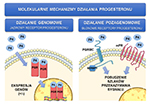Molecular mechanism of progesterone action in the female reproductive system
DOI:
https://doi.org/10.18388/pb.2021_458Abstract
Progesterone (P4) is a steroid hormone which participate in many processes in the female reproductive system. The hormone is produced mainly by the corpus luteum (CL), however, also the ovarian follicles, uterine tissues and placenta are able to produce P4. Progesterone is involved in the regulation of the sexual cycle, as well as in the initiation and maintenance of pregnancy. The hormone may affect cell function by genomic mechanism, through nuclear P4 receptors (PGR), and via nongenomic mechanism, through the membrane P4 receptors, such as progesterone receptor membrane component (PGRMC) 1 and 2, and membrane progestin receptors (mPR) α, β and γ. The genomic mechanism of P4 action leads to the expression of target genes and the synthesis of new proteins, while the nongenomic mechanism modifies various intracellular signaling pathways. The integration of these two mechanisms of P4 activity leads to the suitable regulation of the cell, tissue and, consequently, the response of organism to the hormone.

Published
Issue
Section
License
Copyright (c) 2022 Karolina Dobrzyń, Magdalena K. Kowalik

This work is licensed under a Creative Commons Attribution 4.0 International License.
All journal contents are distributed under the Creative Commons Attribution-ShareAlike 4.0 International (CC BY-SA 4.0) license. Everybody may use the content following terms: Attribution — You must give appropriate credit, provide a link to the license, and indicate if changes were made, ShareAlike — If you remix, transform, or build upon the material, you must distribute your contributions under the same license as the original. There are no additional restrictions — You may not apply legal terms or technological measures that legally restrict others from doing anything the license permits.
Copyright for all published papers © stays with the authors.
Copyright for the journal: © Polish Biochemical Society.



